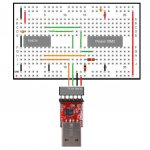Hi all
I have always used a USB serial converter to commnicate with my circuits. However, many of the circuits I have been using lately are very small - using the 08M (and moving to 08M2 very soon ). The problem is that the power supply (even a wall wart) and serial (DB9) converter make the required package very large. My question is whether anyone has a circuit that can use USB communication through to the picaxe and can also supply the 5V needed for the circuit? If so do you need a USB driver for communication and do you need a special command to access this from VB.net?
). The problem is that the power supply (even a wall wart) and serial (DB9) converter make the required package very large. My question is whether anyone has a circuit that can use USB communication through to the picaxe and can also supply the 5V needed for the circuit? If so do you need a USB driver for communication and do you need a special command to access this from VB.net?
Many thanks for any answers
Cheers
Evans_us
I have always used a USB serial converter to commnicate with my circuits. However, many of the circuits I have been using lately are very small - using the 08M (and moving to 08M2 very soon
Many thanks for any answers
Cheers
Evans_us


